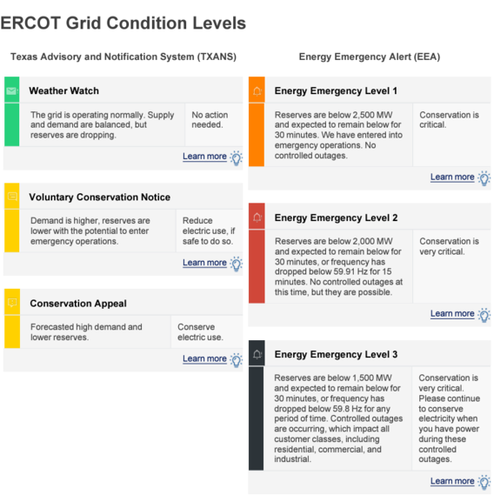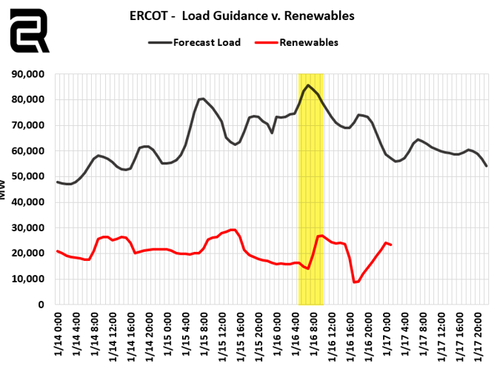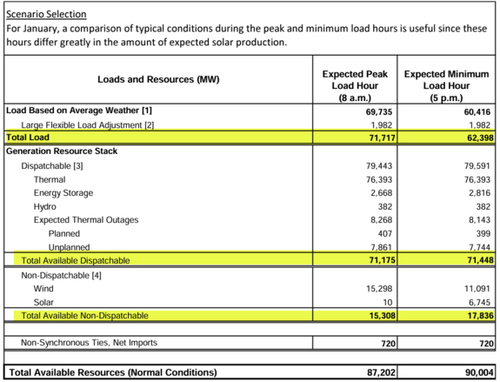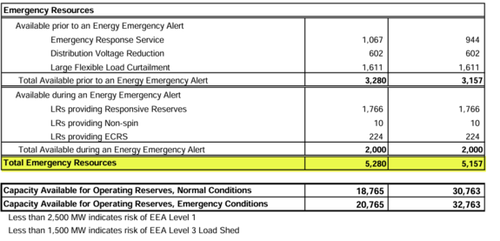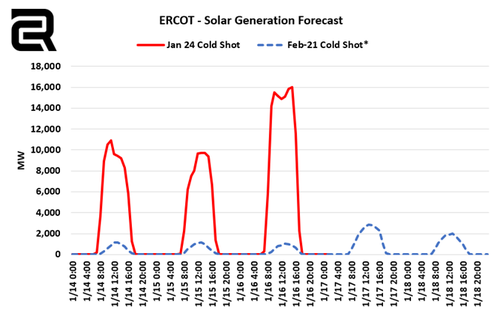Will The Texas Power Grid Survive Next Week’s Polar Vortex?
The National Weather Service’s Climate Prediction Center forecasts extreme cold weather “across the heart of the country this weekend and is expected to continue into next week.” We previewed this cold blast in a note titled “Gobsmackingly Bananas”: Weather Models Predict Polar Vortex Invasion Into US.
Frigid Arctic air will begin to spread southward across the heart of the country this weekend and is expected to continue into next week. Much below normal temperatures along with gusty winds will lead to wind chills well below zero for many locations. pic.twitter.com/doT2gkDqoi
— NWS Weather Prediction Center (@NWSWPC) January 9, 2024
Whenever cold air spills south from Canada into the Heartland, attention usually shifts to Texas.
NWS forecast low temperature [in 7-days] for Texas (statewide average) is 14.8°F for Tuesday.
Last time this cold in January?
Jan 9, 2010: 13.8°F
Jan 21, 1985: 14.1°F
Jan 19, 1984: 14.4°FOverall:
Dec 23-24, 2022 Christmas Eve cold snap 12.2° | 13.0°F
Feb 15-17, 2021… pic.twitter.com/MSRtVEj56q— Ryan Maue (@RyanMaue) January 10, 2024
Next, power demand forecasts from the Electric Reliability Council of Texas, the power grid operator for Texas, are analyzed to see if demand forecasts exceed supply. Current forecasts show ERCOT faces the first major test of grid stability for the new year.
The latest ERCOT 7-day outlook is a bit concerning with next weeks cold… #natgas #ongt pic.twitter.com/B98RcJkwtg
— Criterion Research (@PipelineFlows) January 9, 2024
And this:
#ERCOT now showing an 80 gigawatt peak Monday morning. All time Jan. record is <66GW. For now, ERCOT forecasts plenty of spare capacity. I don't currently anticipate problems but I'd feel a lot better if we had increased energy efficiency the last few years. #txlege #txenergy pic.twitter.com/kbpMcX39JV
— Doug Lewin (@douglewinenergy) January 10, 2024
ERCOT has warned its 26 million Texas customers about the upcoming cold blast this weekend into next week. The grid operator assures customers, “Grid conditions are expected to be normal, and ERCOT expects to have sufficient supply to meet demand.”
ERCOT is closely monitoring the weather conditions moving across Texas this week. Grid conditions are expected to be normal, and ERCOT expects to have sufficient supply to meet demand. Any outages are local in nature. Please contact your local electric provider for information if…
— ERCOT (@ERCOT_ISO) January 8, 2024
Energy-focused research firm Criterion Research told clients in a note Wednesday that ERCOT will likely survive the big cold shot:
ERCOT has issued an Operating Condition Notice (OCN) for the upcoming cold weather event forecast from January 15-17, 2024. The OCN is the first of four levels of communication provided by the agency ahead of a possible Emergency Condition – the following three levels would be Energy Emergency Levels 1 through 3.
ERCOT’s current forecast run shows extreme demand conditions starting on Tuesday, January 16, 2024. That includes a projected peak load of 85,587 MW at 7 AM that morning. However, renewable generation from wind and solar are expected to help out as demand pushes to a seasonal record, with early morning wind + solar contribution 14,137 MW.
ERCOT issues a Monthly Outlook for Resource Adequacy (MORA) every month to provide a look at expectations for both peak load and available generation. The January 2024 MORA gives us a look at how much power the agency plans to have at its disposal during severe events. According to ERCOT, the grid should have approximately 71 GW of dispatchable generation this month. That total does not include projected renewables output as they classify that as “non-dispatchable” load as it can’t be called upon at-will. The guidance range for non-dispatchable load ranges from 18-24 GW for a typical January day.
During the upcoming cold shot, with ERCOT’s projected ‘peak demand’ of 85,587 MW and expected renewables of 14,137 MW, they will need 71,450 MW of dispatchable generation to make up the difference. Fortunately, that demand lines up with their available capacity for January. Should the electricity supply & demand balance tighten, ERCOT also has >5,280 GW in emergency resources at its disposal.
One critical difference between the upcoming cold shot and Winter Storm Uri in 2021 is the massive growth in ERCOT solar capacity. In 2021, Texas solar only accounted for 2-3 GW of peak generation during the day, whereas the agency shows solar at >15 GW during next week’s cold.
But not everyone trusts the grid operator following the devastating blackout three years ago:
“Definitely a lot of people have PTSD from those blackouts that we had in February 2021. Then we had a storm that not as many people remember, Winter Storm Elliott, December 2022. This storm coming up next Monday and Tuesday is looking about as severe as that 2022 storm,” Rice University Professor of Environmental Engineering Daniel Cohan told local news Fox 26.
Cohan noted that ERCOT has made some winterization improvements:
“There have been improvements. They’ve inspected all of the power plants in the state. They’ve made sure the gas grid functions better, so we don’t have the compressors go out when the power goes down.”
The major question is whether the grid operator has enough excess power generation if extremely low wind conditions are seen during the cold blast. Also, if winterization efforts of the grid were properly completed after the cold blast three years ago, which caused billions of dollars in damage.
Meanwhile, the 2023-24 Winter Reliability Assessment report by the North American Electric Reliability Corp. warned late last year that “insufficient energy supply” could emerge during extreme cold blasts.
Here are the most at-risk power grids in the US that might experience blackouts in a cold blast.
It may be time for a reliable full-house petrol-burning generator as the federal government has created more instabilities in the nation’s grid by ramming through unreliable wind and solar to decarbonize grids.
But-but-but what about global warming?
Tyler Durden
Wed, 01/10/2024 – 16:40
via ZeroHedge News https://ift.tt/NlFa7qJ Tyler Durden
